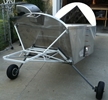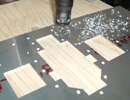


random user submitted photo
source for inexpensive EGT probs
23 posts
• Page 1 of 3 • 1, 2, 3
source for inexpensive EGT probs
I am in need of direction(s) for a source other than ACS, Wicks etc that anyone has used to purchase good inexpensive EGT probes (K type). any suggestions?
Thanks! :)
Thanks! :)
Joe Nelsen
scratch built :D
Sirpeedee, N502PD, s/n 1510, Aero Vee 2.1 s/n 0870,
ADS-B in (Stratux)/out(SkyBeacon)
Flying @81.7
KGYI/N. Tx Reg/Perrin Field
EAA Technical Counselor, Chapter 323, Sherman, TX
scratch built :D
Sirpeedee, N502PD, s/n 1510, Aero Vee 2.1 s/n 0870,
ADS-B in (Stratux)/out(SkyBeacon)
Flying @81.7
KGYI/N. Tx Reg/Perrin Field
EAA Technical Counselor, Chapter 323, Sherman, TX
-

n502pd - Posts: 380
- Joined: Sat Feb 23, 2013 12:13 am
- Location: Gunter, Texas
Re: source for inexpensive EGT probs
Hi Joe, I think it's worth hunting on ebay. Here's an example for $13 each. http://www.ebay.com/itm/EGT-K-Type-Thermocouple-Sensors-with-Clamp-for-Exhaust-Gas-Temperature-/171917396850?hash=item2807134b72:g:hToAAOSwyQtV5xQu which covers a big enough temp range. (Don't know how long that link will work.) You can argue that they are just junky Chinese thermocouples but I paid $60 each for EGT sensors for my Jab 3300 and had 1/3rd fail. My guess is that they came from the same place. I tested a bunch of cheap thermocouples, some that I paid as little as $1 for and some that I made myself. They all worked consistently and were accurate. See http://www.ansoneng.com/sample-page/other-stuff-of-interest/economical-temperature-sensors/. The ones I tested didn't cover a high enough range for EGT sensing, but the one at the ebay link does. It's pretty easy to check them to see that they are working and give the same readings.
Peter
Peter
- peter anson
- Posts: 558
- Joined: Thu Jul 31, 2014 2:34 am
- Location: Mount Macedon, Australia
Re: source for inexpensive EGT probs
You might try GRT 39 Bucks
- sonex569
- Posts: 15
- Joined: Sat Oct 01, 2011 9:34 am
Re: source for inexpensive EGT probs
Thanks fellows for the replys. I shall look in those places! :D
Joe Nelsen
scratch built :D
Sirpeedee, N502PD, s/n 1510, Aero Vee 2.1 s/n 0870,
ADS-B in (Stratux)/out(SkyBeacon)
Flying @81.7
KGYI/N. Tx Reg/Perrin Field
EAA Technical Counselor, Chapter 323, Sherman, TX
scratch built :D
Sirpeedee, N502PD, s/n 1510, Aero Vee 2.1 s/n 0870,
ADS-B in (Stratux)/out(SkyBeacon)
Flying @81.7
KGYI/N. Tx Reg/Perrin Field
EAA Technical Counselor, Chapter 323, Sherman, TX
-

n502pd - Posts: 380
- Joined: Sat Feb 23, 2013 12:13 am
- Location: Gunter, Texas
Re: source for inexpensive EGT probs
peter anson wrote:Hi Joe, I think it's worth hunting on ebay. Here's an example for $13 each. http://www.ebay.com/itm/EGT-K-Type-Thermocouple-Sensors-with-Clamp-for-Exhaust-Gas-Temperature-/171917396850?hash=item2807134b72:g:hToAAOSwyQtV5xQu which covers a big enough temp range. (Don't know how long that link will work.) You can argue that they are just junky Chinese thermocouples but I paid $60 each for EGT sensors for my Jab 3300 and had 1/3rd fail. My guess is that they came from the same place. I tested a bunch of cheap thermocouples, some that I paid as little as $1 for and some that I made myself. They all worked consistently and were accurate. See http://www.ansoneng.com/sample-page/other-stuff-of-interest/economical-temperature-sensors/. The ones I tested didn't cover a high enough range for EGT sensing, but the one at the ebay link does. It's pretty easy to check them to see that they are working and give the same readings.
Peter
Hi Peter! "...some that I made myself." Ha, now that does interest me! have you any drawings, parts list, how to suggestions, on doing that? And how did they work out, and compare with the store bought stuff? Are you still using the home made ones at all? how long have they lasted? :)
Thanks!
Joe Nelsen
scratch built :D
Sirpeedee, N502PD, s/n 1510, Aero Vee 2.1 s/n 0870,
ADS-B in (Stratux)/out(SkyBeacon)
Flying @81.7
KGYI/N. Tx Reg/Perrin Field
EAA Technical Counselor, Chapter 323, Sherman, TX
scratch built :D
Sirpeedee, N502PD, s/n 1510, Aero Vee 2.1 s/n 0870,
ADS-B in (Stratux)/out(SkyBeacon)
Flying @81.7
KGYI/N. Tx Reg/Perrin Field
EAA Technical Counselor, Chapter 323, Sherman, TX
-

n502pd - Posts: 380
- Joined: Sat Feb 23, 2013 12:13 am
- Location: Gunter, Texas
Re: source for inexpensive EGT probs
If getting EGT probes from GRT, recommend their long life version, if you can afford them. Originally got the lower cost ones as part of EFIS package. Got about 3+ years and 200 hours off those. Replaced with their better ones last year.
David A. Sonex TD, CAMit 3300.
David A. Sonex TD, CAMit 3300.
- DCASonex
- Posts: 935
- Joined: Mon Sep 12, 2011 8:04 pm
- Location: Western NY USA
Re: source for inexpensive EGT probs
Thermocouples are easy to make. They are nothing more than the junction between the two wires of special thermocouple wire, each lead of which is a different material. When subjected to heat, a small voltage is generated at the contact between the two dis-similar metals. For CHT thermocouples that are not subject to harsh environments, just crimping the two wires into a ring terminal is sufficient. (Silver solder and welding are sometimes used as well depending on temperature range.) EGT sensors, are subject to blasts of hot and somewhat corrosive exhaust gases and require some form of protective enclosure. That enclosure is what you will pay extra for in better quality units. Thermocouple wire is readily purchased from many sources. Type J thermocouple wire is common for CHT sensors, and type K for the higher temperature EGT sensors, but check specific requirements of unit you are connecting to.
A point often overlooked is that, especially for ring terminal type thermocouples (including the common under-the-plug types) the actual thermocouple, the junction of the two leads, is at a temperature somewhere between the heat source that the ring terminal is bolted to and the much cooler wires leading away from that point. The heat pulled from the ring terminals crimp by cold wires will result in the junction point being a a bit lower temperature than that to which the ring terminal is fastened. Insulating the thermocouple wires from cooling air has been shown to raise the CHT readings on Jabiru and CAMit engines by 15 to 20° F (8 - 11° C) and result in readings closer to the actual temperature of the material to which the thermocouple is fastened. Similarly, an installation that does not positively bond the thermocouple to the heat source to be measured, will result in the point of junction of the thermocouple wires having heat drained off by the cooler wires and result in readings lower than that of the item one might be trying to measure. An example might be sticking a thermocouple junction into a hole in a hot cylinder head, without bonding the thermocouple to the head with some highly conductive material, the point of the junction will be at a temperature somewhere on a gradient between that of the external wires exposed to cooler air and the material of the surrounding hole.
David A. Sonex TD, CAMit 3300.
A point often overlooked is that, especially for ring terminal type thermocouples (including the common under-the-plug types) the actual thermocouple, the junction of the two leads, is at a temperature somewhere between the heat source that the ring terminal is bolted to and the much cooler wires leading away from that point. The heat pulled from the ring terminals crimp by cold wires will result in the junction point being a a bit lower temperature than that to which the ring terminal is fastened. Insulating the thermocouple wires from cooling air has been shown to raise the CHT readings on Jabiru and CAMit engines by 15 to 20° F (8 - 11° C) and result in readings closer to the actual temperature of the material to which the thermocouple is fastened. Similarly, an installation that does not positively bond the thermocouple to the heat source to be measured, will result in the point of junction of the thermocouple wires having heat drained off by the cooler wires and result in readings lower than that of the item one might be trying to measure. An example might be sticking a thermocouple junction into a hole in a hot cylinder head, without bonding the thermocouple to the head with some highly conductive material, the point of the junction will be at a temperature somewhere on a gradient between that of the external wires exposed to cooler air and the material of the surrounding hole.
David A. Sonex TD, CAMit 3300.
- DCASonex
- Posts: 935
- Joined: Mon Sep 12, 2011 8:04 pm
- Location: Western NY USA
Re: source for inexpensive EGT probs
Thanks for the great info! What material is used as the outer part for EGT? Stainless tubing?
Joe Nelsen
scratch built :D
Sirpeedee, N502PD, s/n 1510, Aero Vee 2.1 s/n 0870,
ADS-B in (Stratux)/out(SkyBeacon)
Flying @81.7
KGYI/N. Tx Reg/Perrin Field
EAA Technical Counselor, Chapter 323, Sherman, TX
scratch built :D
Sirpeedee, N502PD, s/n 1510, Aero Vee 2.1 s/n 0870,
ADS-B in (Stratux)/out(SkyBeacon)
Flying @81.7
KGYI/N. Tx Reg/Perrin Field
EAA Technical Counselor, Chapter 323, Sherman, TX
-

n502pd - Posts: 380
- Joined: Sat Feb 23, 2013 12:13 am
- Location: Gunter, Texas
Re: source for inexpensive EGT probs
Hi Joe, I'll go along with David on this, although all the types I tried were K-type. I bought a coil of thermocouple wire on eBay. It's supposed to be good for up to 500 C, so not suitable for EGT. I assume that the controlling factor there is the insulation material. The wire comes as an insulated pair covered with a woven stainless steel shield. I just stripped back the insulation and twisted the bare wires tightly together. I tried both crimped and welded connections. To weld them I just "touched" the tip of the twist with an oxy-acetylene flame. Output was the same for both crimped and welded sensors. I think it's quite feasible to make your own CHT sensors. The problem of insulating the sensors from the cooling air blast is just the same whether you are using commercial or home-made parts.
EGT sensors have a stainless steel shield so it would be possible to make your own if you are a good TIG welder. The high temperature wire might be a bit harder to come by. Because of the added complication I think you would be better off buying commercial EGT sensors.
Peter
EGT sensors have a stainless steel shield so it would be possible to make your own if you are a good TIG welder. The high temperature wire might be a bit harder to come by. Because of the added complication I think you would be better off buying commercial EGT sensors.
Peter
- peter anson
- Posts: 558
- Joined: Thu Jul 31, 2014 2:34 am
- Location: Mount Macedon, Australia
Re: source for inexpensive EGT probs
n502pd wrote:Thanks for the great info! What material is used as the outer part for EGT? Stainless tubing?
There are about as many grades of stainless steel as there are of aluminum. Some will hold up far better to corrosive fumes and repeated heating and cooling cycles than others. I am not going to pretend to be a metallurgist and recommend any. As Peter said, probably better off purchasing known quality EGT probes, but very little risk in making your own thermocouples for CHT and other such applications.
David A.
- DCASonex
- Posts: 935
- Joined: Mon Sep 12, 2011 8:04 pm
- Location: Western NY USA
23 posts
• Page 1 of 3 • 1, 2, 3
Who is online
Users browsing this forum: No registered users and 100 guests







